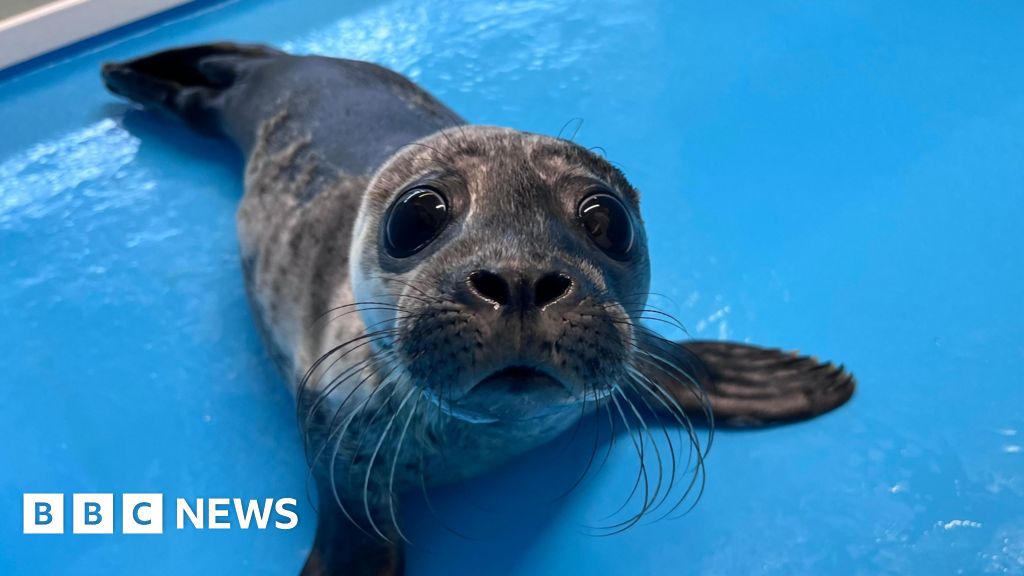
BBCTHIS FUEM DE SEAL DE JULHORES DE DOIS WEWEK foi resgatado do porto de Belfast. É a estação do foca de filhote na costa da Irlanda do Setentrião, mas os membros do público estão sendo convidados a olhar à intervalo e não se aproximarem dos filhotes. “O desarrimo é a maior questão que vemos cá, e muito disso é porque eles nascem no Boly Public Prays”, disse um center de reproduções de reproduções de restauração em que o Keeper, em Keeper. Experiência entre uma mãe e seu filhote. “Alguns anos detrás, tivemos um selo cinzento que foi movido por alguns membros do público e voltamos no dia seguinte para checá -lo e ele foi mordido por toda secção”, disse Euan. “We think he went up to mum looking for food and she didn’t know who he was and tried to get rid of him.”Euan Morrison is head keeper at the Seal Rescue and Rehabilitation CentreSince opening its doors in 1989, the sanctuary has helped rehabilitate and return nearly 600 sick, injured, or abandoned seal pups back into the wild.With a new season beginning, staff at the centre are bracing themselves for another busy period with five harbour pups already permitido. As focas são legalmente protegidas contra matar e distúrbios intencionais ou imprudentes. O meio fundamentado em Portaferry pediu ao público que estivesse vigilante aos mamíferos neste verão, tirando fotos de uma intervalo e entrando em contato com eles, se eles não tenham que se evidenciar, que não se esforçam, que não estão tentando, que não se esforçam, que não estão tentando, que não se esforçam para que eles não estivessem, que não estão tentando, que não se esforçam. O olho em cães também é realmente importante. “‘As focas do porto são a nossa maior preocupação-o meio resgata entre 20 a 30 focas por ano. Duas espécies de focas habitam a costa e os mares da Irlanda do Setentrião, de harmonia com o Departamento de Cultivação, Meio Envolvente e Afastos Rurais (DAERA). Foram murado de 1.185 focas portuárias na costa na Irlanda do Setentrião, em conferência com murado de 3.165 focas cinzentas. Porque do número de população mais plebeu, o santuário priorizou os esforços de conservação em torno de seus selos de porto. recoveryFrom rescue to release, the road to re-entering the wild has several stages including being placed in a hospital pen, feeding, learning to swim and socialise with other seals in a nursery pool, and finally learning to swim and feed in deeper waters in a pre-release pool.If all goes to plan the five seal pups will be released back into the sea in October.Aran Pollock, who is part of the bicho care team, said without the round-the-clock care provided by the sanctuary many of the seal pups would starve or freeze to death.”When you see them come in, some of them are in awful condition, they’re just tiny,” he said.The seals are cared for by staff at the centre and tube-fed milk to build their strength before they are released.”Once we have taken care of them enough, once we know that they can eat fish by themselves, when we know that they can swim very well in our deep pool, then there are pretty much no worries.”However, each released seal has a tag so staff are able to keep an eye on their rescues even when they return to the wild.What to do if you spot a seal pupGrey seal pupping typically runs from the end of June into July.Baby seals are born with a white fluffy coat to keep them warm and rarely enter the water in their first few weeks, so it is not uncommon to see them on beaches, rocks, and harbours around the coast.Seals will often leave pups on the shore to Caça de comida e pode não retornar se houver muitas pessoas na superfície ao volta do filhote. Os membros do público não devem tentar restituir um selo à chuva. O Exploris aconselha as pessoas a manter os cães em uma liderança ao caminhar nas praias, alertando que os selos cinzentos em privado são capazes de infligir mordidas desagradáveis e podem prejudicar cães.








